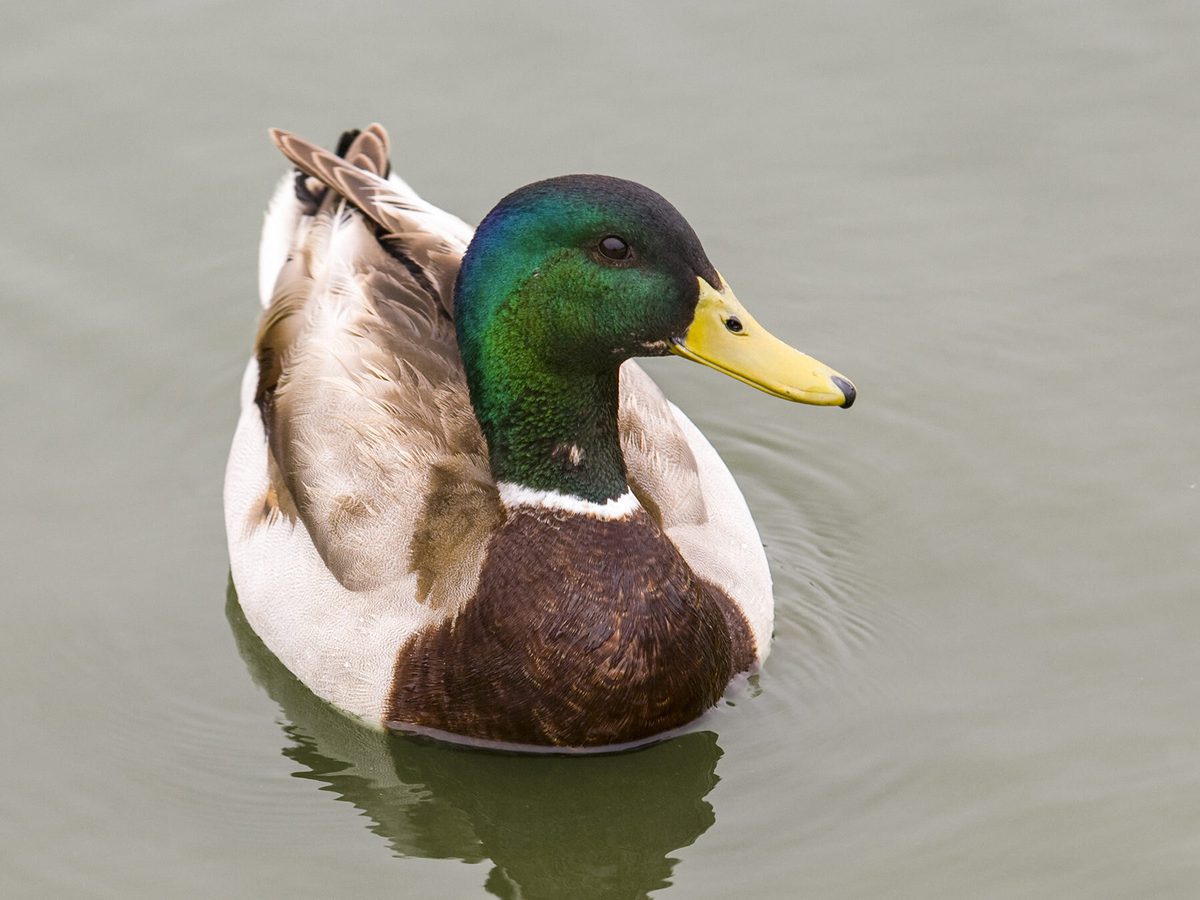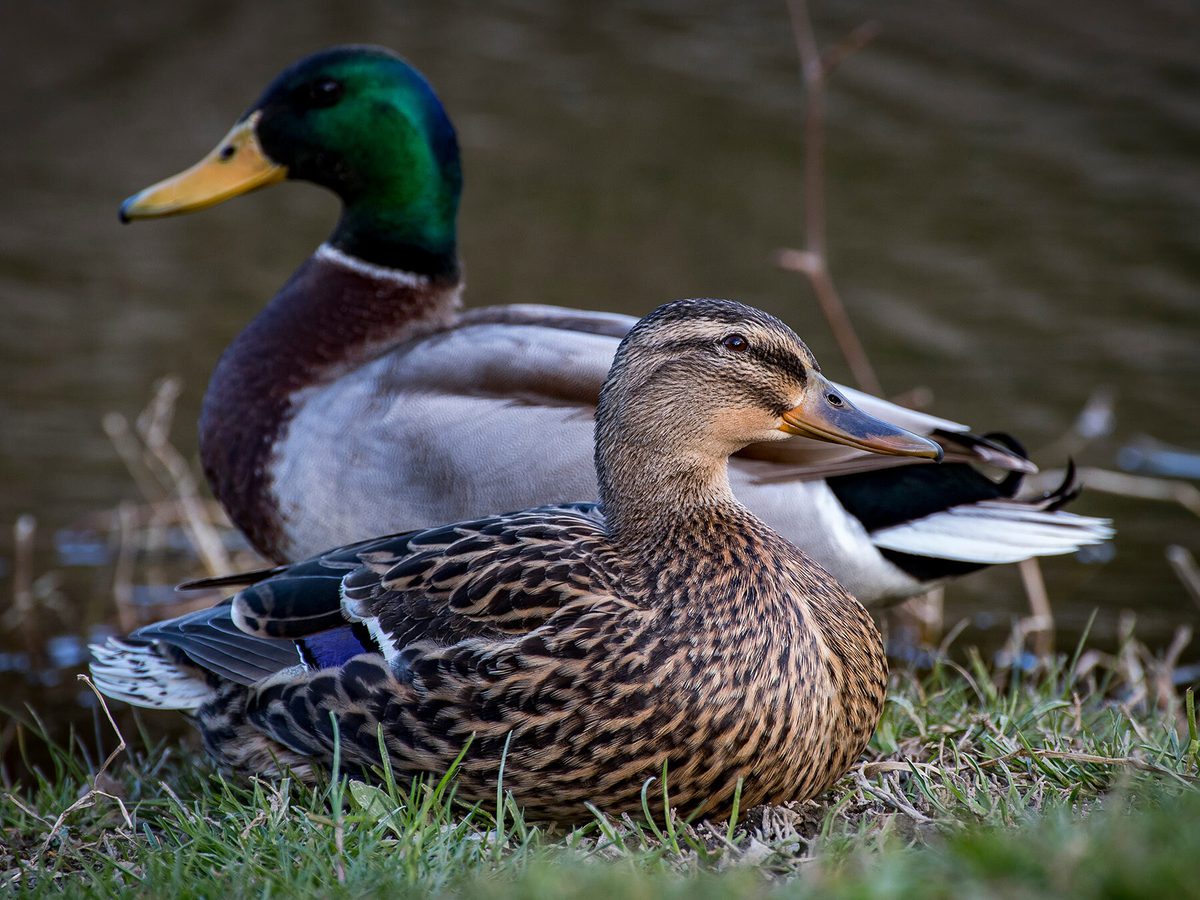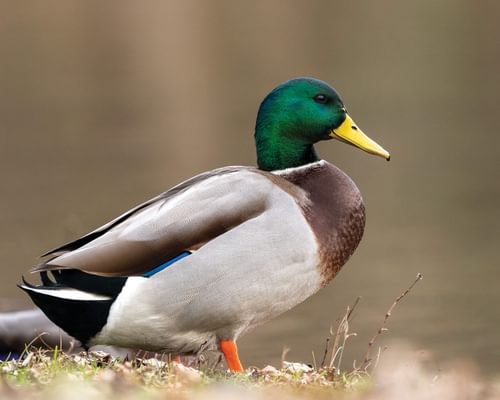The mallard (Anas platyrhynchos) is the most abundant duck species in North America. In fact, ‘Greenheads’, as they are affectionately known are probably the most familiar duck species in the world.
These elegant birds occur throughout most of North America, Europe, Asia, and are even winter visitors to parts of Africa. The mallard is also the ancestor of the domestic duck which is a common poultry and ornamental bird all over the globe.
Mallards have been recorded to live for nearly 30 years in the wild, although the average individual is not likely to reach the age of two. In captivity, mallards are likely to survive longer than wild birds if given good care. One captive mallard in the United Kingdom is a great example of their potential longevity. This male, named ‘Ernie’, lived to be at least 21 years of age.
Mallards can fall prey to a pretty wide variety of predators, including mammals, birds, reptiles, and even fish. These animals feed on mallards opportunistically or target them specifically. Mallards are also very popular with hunters across the United States and millions of these waterfowl are harvested each year.
In addition to predators and hunters, mallards can also succumb to a variety of natural causes like extreme weather and illnesses caused by viruses, parasites, bacteria, and fungi. Continue reading to learn more about these and other factors that affect the lifespan of mallards.

In the wild, it's common for Mallards to only live for two years
How long do mallards live in the wild?
On average, mallards live for less than two years in the wild. Most mallards never reach maturity, and it is estimated that as little as a quarter of the eggs laid will hatch and produce ducklings that reach fledging age.
Mallards that are able to reach breeding age are likely to live about 3 years, but they can live much longer. In fact, wild mallards can live for over two decades under ideal circumstances.
How long do mallards live in captivity?
With good care, mallards are likely to survive longer in captivity than out in the wild. Domestic ducks, which were bred from wild mallards, are reported to live for five to ten years on average.
The Guinness record for the oldest duck in captivity was a pair of domestic ducks in South Africa that lived for 49 years. This record should probably be taken with a pinch of salt since the next oldest recorded mallard was about 20 years younger!

In captivity, Mallards tend to live longer, and can usually reach between five and ten years old
How do most mallards die?
Wild mallards die from many natural, and human-related causes. Continue reading to learn more about the most common causes of mallard mortality.
Weather
Mallard ducklings are not very cold-hardy and can perish at temperatures of just 28-32 °F (0 to -2°C). This makes the young birds vulnerable to cold snaps. Hail storms can also cause significant losses of mallards and other birds that occupy open habitats. One hail storm over Montana killed an estimated 11 000 waterbirds (of a variety of species) in a single night in 2019.
Illness
Mallards can be affected by many bacterial, fungal, and viral infections. At times, outbreaks can take as many as a quarter of a million ducks in a single area, as was the case in Utah in 1932.
Recorded infections in mallards include the following:
- Avian cholera
- Avian influenza
- Avian botulism
- Aspergillosis
Mallards can also be host to a variety of parasites that can affect their health. These include leeches, lice, nematodes, trematodes, and cestodes.

Male mallard in flight
Predation
Mallards are vulnerable to predation at all stages of their life, from eggs in the nest, as hatchlings, and even as adults. Female mallards are particularly vulnerable to predation while incubating their eggs since they are so easily caught by mammals while nesting on the ground. The impact of predation on incubating females is so significant that it is thought to explain the larger ratio of adult male to female mallards.
Hunting
Hunters account for millions of ducks each year in the United States, and mallards are the most popular and extensively harvested species. There were over a million active waterfowl hunters during the 2020-2021 season and they harvested 2.8 million mallards in that period.
What is the life cycle of a mallard?
Mallards mate for life but are not strictly faithful to their partners. These birds often pair up in the winter but the eggs are only laid in the spring. The female mallard prepares the nest by creating a shallow scrape on the ground and pulling in some material from the immediate vicinity.
Female mallards lay up to 13 eggs in a clutch and incubate these eggs for 23-30 days. Mallard ducklings are precocial, which means they are physically developed from the time they hatch. They leave the nest within a single day and can feed themselves immediately. Their mother will lead them to water and food sources, however, and brood them for the first two weeks or so.
The mother mallard will stay with the ducklings for about 50 days until they can fly. The young ducks will learn more about foraging grounds in the area by following other adult mallards. Mallards are ready to mate and start a new generation at the age of 1 year.

Close up of a Mallard duckling
What are the predators of mallards?
Mallards are vulnerable to predation at all stages of their life. They are eaten by a wide variety of predators, including various small mammals like foxes, predatory birds like hawks and eagles, and even large carnivorous fish.
Continue reading for a breakdown of the mallards’ most important predators.
Foxes, skunks, crows, ravens, magpies, and gulls have all been recorded preying on mallard eggs. The mink is a major predator of mallard hatchlings but a large variety of opportunistic predators will feed on mallard ducklings when available. These include other mammals, birds, reptiles, and even large fish like largemouth bass and muskellunge.
Adult mallards have fewer enemies than ducklings but are still taken by a variety of predators. The following mammal species have all been recorded preying on mallards:
- Red fox
- Mink
- Coyote
- Raccoon
- Long-tailed weasel
Birds of prey are also important mallard predators. In North America, mallards are fed on by the following raptor species:
- Great horned owl
- Peregrine, prairie, and gyrfalcons
- Northern goshawk
- Golden and bald eagles
- Swainson’s, red-tailed, and ferruginous hawks
- Northern harriers

A female Mallard swimming on the water
How old is the oldest mallard?
The oldest reliable record of a mallard was a bird recovered in Iowa. This bird lived an impressive 29 years and 1 month in the wild. A close contender was an individual from Arkansas that lived to the ripe old age of 27 years and 7 months.
How long can mallards live without food?
Mallards will feed every day if possible. The length of time they can survive without feeding will depend on how much energy they are using, and this correlates pretty closely with the ambient temperature.
Another important factor that governs how long a mallard can survive without food is the amount of stored energy (fat) the bird has.

A pair of Mallards together in the winter
How do mallards survive winter?
Mallards can survive winter conditions across most of the United States. Individuals that breed in Canada and Alaska, however, are not able to survive the harsh northern winters and migrate south each year to overwinter in Mexico and the southern USA.
Adult mallards are well equipped to survive cold temperatures. These birds have excellent insulation in the form of dense feathers, and they are able to store large fat reserves. This allows them to survive for short periods but they will move to warmer areas when water bodies freeze over and food becomes inaccessible.
Are mallards endangered?
Mallards have an extremely large worldwide distribution and population size. They are not endangered and are ranked as a ‘least concern’ species according to the International Union for Conservation of Nature (IUCN). This means the species is currently thriving and in no danger of extinction.

